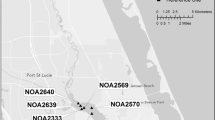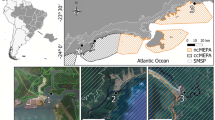Abstract
Sediment toxicity of different areas of Spanish littoral was evaluated using an internationally recommended 10 day acute toxicity test with the amphipod Ampelisca brevicornis. Sediment samples from Santander Bay (N Spain), Las Palmas of Gran Canaria (SW Spain), Algeciras Bay (S Spain) and Ría of Huelva (SW Spain) were collected and organic carbon, fines, metals Zn, Cd, Pb, Cu, Ni, Co and Hg, PAHs and PCBs were analyzed for their characterization. Significant toxic effects compared with control site (P < 0.05) were observed after exposure to the sediments from Las Palmas of Gran Canaria port, from 83.3% of the sites studied in Algeciras Bay and from Ría of Huelva. These effects were associated (P < 0.05) with PCBs and metals Zn, Cd, Pb and Cu in Ría of Huelva and to Ni and Co in the rest of sites. Chemical measurements were compared with international sediment quality guidelines and site-specific guidelines were derived.



Similar content being viewed by others
References
Casado-Martínez MC, Beiras R, Belzunce MJ, González-Castromil MA, Marín-Guirao L, Postma JF, Riba I, DelValls TA (2006) Inter-laboratory assessment of marine bioassays to evaluate environmental quality of coastal sediments in Spain: III. The whole sediment toxicity test using crustacean amphipods. Cienc Mar 32:149–157
Casado-Martínez MC, Forja JM, DelValls TA (2007) Direct comparison of amphipod sensitivities to dredged sediments from Spanish ports. Chemosphere 68:677–685
CCME (Canadian Council of Ministers of the Environment) (1995) Protocol for the derivation of Canadian sediment quality guidelines for the protection of aquatic life. CCME EPC-98E. Environment Canada, Guidelines Division, Technical Secretariat of the CCME Task Group on Water Quality Guidelines, Ottawa. [Reprinted in Canadian environmental quality guidelines (1999), Chapter 6, Canadian Council of Ministers of the Environment, 1999, Winnipeg]
CEDEX (Centro de Estudios y Experimentación de Obras Públicas) (1994) Recomendaciones para la gestión del material de dragado en los puertos españoles. Ministerio de Obras Públicas, Transporte y Medio Ambiente, Madrid
DelValls TA (2007) Diseño de modelos integrados de evaluación de la contaminación y sus efectos sobre los sistemas marinos y litorales y la salud humana.: Ministerio de la Presidencia. Centro para la Prevención y Lucha contra la Contaminación Marítima y Litoral (CEPRECO)-Serie Investigación, Madrid
DelValls TA, Chapman PM (1998) Site-specific sediment quality values for the Gulf of Cádiz (Spain) and San Francisco Bay (USA), using the sediment quality triad and multivariate analysis. Cienc Mar 24:313–336
DelValls TA, Andres A, Beldunce MJ, Buceta JL, Casado-Martínez MC, Castro R, Riba I, Viguri J, Blasco J (2004) Chemical and ecotoxicological guidelines for managing disposal of dredged material. Trends Anal Chem 23(10–11):819–828
Falco GD, Magni P, Teräsvuori LMH, Matteucci G (2004) Sediment grain size and organic carbon distribution in the Cabras lagoon (Sardinia, Western Mediterranean). Chem Ecol 20(1):367–377
González-Piñuela C, Alonso-Salces RM, Andrés A, Ortiz I, Viguri JR (2006) Validated analytical strategy for the determination of polycyclic aromatic compounds in marine sediments by liquid chromatography coupled with diode-array detection and mass spectrometry. J Chromatogr A 1129:189–200
Long ER, MacDonald DD, Smith SL, Calder FD (1995) Incidence of adverse biological effects within ranges of chemical concentrations in marine and estuarine sediments. Environ Manage 19:81–97
MacDonald DD, Carr RS, Calder FD, Long ER, Ingersoll CG (1996) Development and evaluation of sediment quality guidelines for Florida coastal waters. Ecotoxicology 5:253–278
Martín-Díaz ML, Blasco J, Sales D, DelValls A (2007a) Field validation of a battery of biomarkers to assess sediment quality in Spanish ports. Environ Pollut 20:1–10
Martín-Díaz ML, Kalman J, Riba I, Fernández de la Reguera D, Blasco J, DelValls TA (2007b) The use of a metallothionein-like-proteins (MTLP) kinetic approach for metal bioavailability monitoring in dredged material. Environ Int 33:463–468
Martín-Díaz ML, Sales D, DelValls TA (2008a) Toxicokinetic approach for the assessment of endocrine disruption effects of contaminated dredged material using female Carcinus maenas. Ecotoxicology 17(6):495–503
Martín-Díaz ML, Jiménez-Tenorio N, Sales D, DelValls TA (2008b) Accumulation and histopathological damage in the clam Ruditapes philippinarum and the crab Carcinus maenas to assess sediment toxicity in Spanish ports. Chemosphere 71(10):1916–1927
Morales-Caselles C, Kalman J, Riba I, DelValls TA (2007) Comparing sediment quality in Spanish litoral areas affected by acute (Prestige, 2002) and chronic (Bay of Algeciras) oil spills. Environ Pollut 146:233–240
Morales-Caselles C, Kalman J, Micaelo C, Ferreira AM, Vale C, Riba I, DelValls TA (2008) Sediment contamination, bioavailability, toxicity of sediments affected by an acute oil spill: four years after the sinking of the tanker Prestige (2002). Chemosphere 71:1207–1213
Ramos-Gómez J, Martín-Díaz ML, Rodríguez A, Riba I, DelValls TA (2008) In situ evaluation of sediment toxicity in guadalete estuary (SW Spain) after exposure of caged Arenicola marina. Environ Toxicol 23(5):643–651
Riba I, Zitko V, Forja JM, DelValls TA (2003) Deriving sediment quality guidelines in the Guadalquivir estuary associated with the Aznalcóllar mining spill: a comparison of different approaches. Cienc Mar 29(3):261–274
Riba I, Casado-Martínez C, Forja JM, Delvalls TA (2004) Sediment quality in the Atlantic coast of Spain. Environ Toxicol Chem 23(2):271–282
US EPA (United States Environmental Protection Agency) (1994) Methods for assessing the toxicity of sediment-associated contaminants with estuarine and marine amphipods (EPA/600/R-94/025). Office of Water, Washington
US EPA (United States Environmental Protection Agency) (1996) Method 8082, Polychlorinated biphenyls (PCBs) by gas chromatography. Test methods for evaluating solid waste, vol. 1B: laboratory manual, physical/chemical methods (SW-846), 3rd edn. US Government Printing Office, Washington (Update 3, Revision 0)
Acknowledgments
This study was part of the project INTEGRAL (CTM2005-07282-C03-01/TECNO), supported by the Spanish Ministry of Education and Science (MEC). Julia Ramos-Gómez work was funded by a MEC fellowship (FPU). The authors would like to thank the members of the CSIC, CIS and the University of Cantabria and Las Palmas for their cooperation. Special thanks are given to Camille and William for their invaluable help during the bioassay. The manuscript has been English edited by M Carmen Ramos Gómez.
Author information
Authors and Affiliations
Corresponding author
Rights and permissions
About this article
Cite this article
Ramos-Gómez, J., Martín-Díaz, M.L. & DelValls, T.A. Acute toxicity measured in the amphipod Ampelisca brevicornis after exposure to contaminated sediments from Spanish littoral. Ecotoxicology 18, 1068–1076 (2009). https://doi.org/10.1007/s10646-009-0383-5
Received:
Accepted:
Published:
Issue Date:
DOI: https://doi.org/10.1007/s10646-009-0383-5




